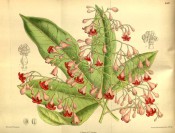Brachychiton acerifolius (A.Cunn. ex G.Don) Macarthur & C.Moore
Frost tender, open, evergreen or briefly deciduous tree with glossy, leaves, either simple and ovate, or 3- to 5-lobed, often on the same plant, and large, terminal, panicle-like cymes of bowl-shaped, bright coral-red flowers, to 2cm across, in summer, usually before the leaves. To 35m. [RHSE, Hortus, Beadle].
Horticultural & Botanical History
‘The Flame Tree, for such is the name given in Queensland and New South Wales to the species which forms the subject of our plate, is a tree which attains, in its native forests, a height of from sixty to a hundred and twenty feet, with a trunk three feet through; it yields a soft light-coloured wood. According to Loudon the species was first introduced into England in 1824, and there is a drawing in the collection at Kew made from a plant growing in the Royal Gardens in 1826. This drawing bears a note to the effect that the plant was introduced from New South Wales in 1825. In the garden of Lady Hanbury at La Mortola, Ventimiglia, B. acerifolius thrives in the open air, but at Kew it can only be grown under glass, and the material for our illustration has been obtained from a plant which is grown in one of the beds in the central portion of the Temperate House, and is now a tree about forty feet high. This plant has been in cultivation at Kew since 1862, when it was presented to the national collection by Messrs. J. Veitch & Sons, Chelsea.’ [BM t.8437/1912].
History at Camden Park
Listed in all published catalogues [T.945/1843]. First described under the name Brachychiton acerifolius by William Macarthur and Charles Moore as part of the the New South Wales exhibit at the Paris Exhibition of 1855. Macarthur described its garden treatment in a letter to Loddiges Nursery, 13th February, 1848: ‘Has the Sterculia acerifolia ever flowered yet? It is of singular beauty in blossom and occasionally flowers at the height of four or five feet. You should starve it at the commencement of summer by gradually withdrawing water until it loses nearly all its leaves and after a short interval excite it again. It will then probably cover itself with long loose racemes of bright coral coloured flowers which last in succession several weeks. I have distinguished the plant by its brilliant colour when in blossom in thick woods on the side of abrupt mountains at more than two miles distance. All these New Holland ‘brush’ plants, Bignonia jasminoides, Araucarias etc, like rich, light loam full of loose stones, old mortar, and rough charcoal. You cannot make the soil for them too loose with rock materials, but there is nothing like sand or peat where they grow. I should grow them in little else but decomposing turf from a dry pasture, lumps of charcoal or pieces of freestone, decomposing if possible, with just as much very coarse sand as would be sufficient to keep the rooten turf permeable to water.’ [MP A2933-1, p.172].
Notes
Published Mar 07, 2010 - 03:47 PM | Last updated Jul 31, 2010 - 04:32 PM
| Family | Sterculiaceae |
|---|---|
| Category | |
| Region of origin | Eastern Australia |
| Synonyms |
|
| Common Name | Flame tree, Flame kurrajong, Illawarra flame tree |
| Name in the Camden Park Record |
Sterculia acerifolia - Flame tree |
| Confidence level | high |


